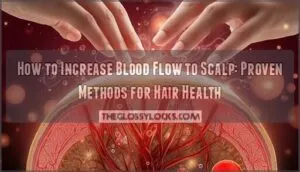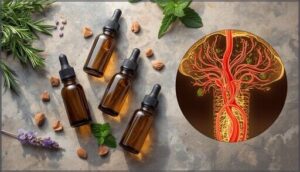This site is supported by our readers. We may earn a commission, at no cost to you, if you purchase through links.
Your hair follicles need a steady supply of oxygen and nutrients to produce strong, healthy strands—but when blood flow to your scalp slows down, those follicles start to struggle. Poor circulation can trigger a cascade of problems: thinning hair, slower growth cycles, and follicles that gradually shrink and weaken.
The good news? You don’t need expensive treatments to turn things around. Simple techniques like targeted scalp massage, specific essential oils, and strategic lifestyle adjustments can dramatically improve circulation to your scalp.
Understanding how blood flow affects your hair—and knowing which methods actually work—gives you real tools to strengthen your follicles from the root up.
Table Of Contents
Key Takeaways
- Your hair follicles depend on consistent scalp blood flow to deliver oxygen and nutrients, and research shows men with pattern baldness have 2.6 times lower circulation than those without hair loss—but targeted interventions like daily scalp massage (10-20 minutes) can improve growth in 69% of users within months.
- Simple, evidence-backed techniques work: rosemary oil rivals minoxidil’s effectiveness, contrast showers trigger vascular pumping action, and inversion poses combined with scalp stimulation show 68.9% of practitioners stabilizing hair loss after six months of consistent practice.
- Your diet and lifestyle directly impact follicle health—adequate B vitamins, iron, omega-3s, and hydration increase blood volume and nutrient delivery, while stress reduction techniques lower cortisol that constricts blood vessels and chokes circulation.
- Advanced treatments show measurable results: 5% minoxidil formulations boost circulation within 15 minutes with 68% stopping loss after six months, red light therapy at 660-850 nm wavelengths increases growth by 35% after 26 weeks, and VEGF therapy enhances scalp microvascularization by over 30%.
Why Scalp Blood Flow Matters for Hair Health
Your scalp’s blood flow isn’t just background biology—it’s the lifeline your hair follicles depend on to thrive. When circulation falters, your hair pays the price in ways you’ll notice. Understanding this connection gives you real control over your hair’s health and growth potential.
Your scalp’s blood flow is the lifeline your hair follicles depend on to thrive
The Link Between Circulation and Hair Growth
Your hair follicles depend on blood circulation to thrive. Blood flow dynamics deliver oxygen and nutrients that fuel the angiogenesis process—forming new blood vessels during growth phases.
When scalp microcirculation improves, vascular endothelial growth factors kick in, extending your hair’s lifespan and thickness.
Simple techniques like scalp massage work by enhancing blood flow, directly improving blood circulation to support hair follicle health naturally. Regular scalp massage can increase blood flow naturally to promote healthy hair growth.
Effects of Poor Scalp Blood Flow
When scalp circulation issues persist, your follicles suffer. Studies show men with pattern baldness have 2.6 times lower blood flow than those without hair loss. Poor blood circulation causes three main problems:
- Follicle miniaturization as hair shafts shrink and weaken
- Hair follicle damage from oxygen and nutrient deprivation
- Disrupted hair growth patterns that shorten your growth phase
Improving blood circulation through scalp massage and lifestyle changes can reverse these effects. Understanding the importance of blood flow therapy is essential for maintaining healthy hair follicles.
Role of Blood Vessels and Nutrients
Your follicles rely on a dense network of arteries, veins, and capillaries to function. These blood vessels transport oxygen, iron, B vitamins, and growth factors directly to the dermal papilla region where hair forms.
Improved vascular health through blood flow stimulation can extend your growth phase by up to 120%, while deficient angiogenesis factors contribute to follicle miniaturization and thinning.
Signs of Poor Scalp Circulation
Your scalp sends signals when it’s not getting enough blood flow, and recognizing these warning signs early can help you protect your hair. Poor circulation doesn’t happen overnight—it builds gradually, showing up in ways you might dismiss as normal aging or stress.
Let’s look at the telltale symptoms that indicate your scalp needs better circulation.
Common Symptoms to Watch For
Your body often sends signals when something’s off with scalp health. Dull hair causes include inadequate blood circulation delivering nutrients to follicles. You might notice itchy scalp issues, scalp sensitivity, or tingling sensations across your head.
Hair breakage patterns can emerge alongside dryness and flakiness. Some people experience coldness or numbness where blood flow is compromised, warning signs that your circulatory health needs attention before visible hair loss develops.
Hair Loss and Thinning Indicators
Noticing changes in your hair density signals something deeper at work. Hair loss rates climbing past 100 strands daily often point to compromised blood circulation starving your hair follicles. Poor blood flow triggers recognizable patterns:
- Gradual hairline recession or crown thinning developing over months
- Thinner hair shafts that break easily despite gentle handling
- Patchy areas where follicles weaken from inadequate scalp stimulation
- Slower regrowth after shedding episodes
Addressing circulation early aids in balding prevention.
Scalp Health and Sensitivity
Discomfort often reveals what your eyes miss. Between 25% and 70% of people experience scalp sensitivity—itching, burning, or tenderness that flares from stress or inflammation. Women report these symptoms more frequently, especially after age 50.
Neurogenic inflammation triggered by stress disrupts blood circulation around hair follicles, compromising scalp health.
Regular scalp massage and targeted scalp care techniques can counter sensitivity triggers while improving blood vessel function and scalp stimulation.
Proven Techniques to Boost Scalp Blood Flow
You don’t need expensive treatments to improve circulation to your scalp. Simple, research-backed techniques can make a real difference in how well blood reaches your hair follicles.
Here’s what actually works, based on clinical evidence and patient results.
Scalp Massages and Pressure Points
Think of scalp massage techniques as a direct line to healthier follicles. Applying firm, circular pressure for 10-20 minutes daily delivers measurable results—studies show 69% of participants saw improved hair growth after consistent twice-daily sessions.
Pressure point therapy targeting specific areas like Baihui enhances blood circulation and scalp stimulation methods, while massage oil benefits support nutrient delivery, making scalp care techniques essential for vigorous blood flow enhancement.
Essential Oils for Circulation
Certain essential oils act as natural vasodilators, widening blood vessels to increase scalp circulation. Rosemary oil rivals minoxidil’s effectiveness by enhancing follicle stimulation, while peppermint oil’s menthol delivers nutrients faster through improved blood flow. Cedarwood properties include balancing oil production and activating dormant follicles. Lavender oil reduces inflammation that blocks circulation.
Apply these diluted oils with aromatherapy techniques—gentle massage amplifies their circulation-boosting benefits markedly.
Hair Brushing Methods
Your hairbrush isn’t just detangling—it’s a circulation tool. The right brush types paired with proper technique stimulate blood flow without damage. Here’s how to optimize this simple method:
- Choose boar bristle or paddle brushes with flexible bristles to boost scalp massage effects
- Brush 1-2 times daily—more frequent strokes risk breakage and irritation
- Start at hair ends, moving upward with gentle brushing motions
- Apply light pressure using circular patterns to dilate capillaries
- Brush on damp hair rather than wet to reduce mechanical stress
Studies show 4-minute daily sessions improve hair thickness through enhanced blood circulation.
Inversion Method and Yoga Poses
Positioning your head below your heart triggers an immediate blood flow boost—gravity does the heavy lifting. The inversion method combines this with scalp stimulation using warm oils for hair regrowth. Hold inverted postures for 4 minutes daily over seven consecutive days, then rest for three weeks.
Inversion therapy shows promise—68.9% of consistent practitioners report stabilized loss after six months. However, skip this technique if you have high blood pressure, glaucoma, or heart conditions. Rise slowly to prevent dizziness.
| Yoga Poses for Blood Circulation | Primary Benefit | Recommended Duration |
|---|---|---|
| Downward-Facing Dog | Enhanced scalp oxygenation | 1-2 minutes |
| Headstand (Sirsasana) | Maximum blood flow boost | 30-60 seconds |
| Camel Pose (Ustrasana) | Stress hormone reduction | 30-45 seconds |
Contrast Showers and Cold Water Therapy
Beyond holding inverted poses, alternating water temperatures creates a vascular workout for your scalp. Contrast showers trigger vasoconstriction during cold exposure, then rapid vasodilation when you switch back to warmth—this pumping action delivers oxygen and nutrients directly to follicles.
Try 2-3 minutes hot, then 30 seconds cold, repeating three cycles. The nitric oxide boost from cold water stimulation strengthens vessel walls while enhancing circulation for measurable hair growth benefits.
Lifestyle and Dietary Changes for Better Circulation
What you eat and how you live directly affect your scalp’s circulation. Small shifts in your diet, hydration, exercise habits, and stress management can make a real difference in blood flow to your hair follicles.
Here’s what actually works when you want to strengthen your hair from the inside out.
Key Vitamins and Nutrients for Scalp Health
Your hair follicles need the right fuel to thrive. Nutrient delivery through blood circulation depends on what you eat—deficiencies can sabotage even the best hair care routines.
Key nutrients for scalp blood flow and hair health:
- B vitamins like biotin supplements and niacin boost keratin production and improve blood circulation to your scalp
- Iron deficiency starves follicles of oxygen—pair iron-rich foods with vitamin C for better absorption
- Omega 3 sources (salmon, walnuts) plus adequate zinc intake maintain scalp hydration and regulate oil production
Vitamin D benefits cell creation, while a healthy diet with dietary supplements fills nutritional gaps.
Hydration and Its Impact on Blood Flow
Drinking enough water isn’t just about quenching thirst—it’s circulation enhancement at its simplest. Proper hydration increases blood volume, helping nutrient delivery and oxygen supply reach your follicles efficiently.
When you’re dehydrated, blood thickens and flow slows, starving roots of what they need.
Maintaining fluid balance with adequate electrolyte role support keeps blood circulation humming, giving your scalp the hydration therapy it deserves for healthier growth.
Exercise Routines for Improved Circulation
Getting your body moving pays off where it matters most—your scalp. Aerobic exercise like jogging or cycling pumps oxygen-rich blood straight to your follicles, while resistance exercises strengthen your cardiovascular system for better overall circulation.
Add yoga inversions like downward dog or headstands to your routine, and you’ll direct blood flow exactly where hair growth happens.
Aim for 30 minutes of cardio workouts three to four times weekly for measurable results.
Stress Reduction and Breathing Exercises
When stress ramps up, your scalp pays the price—cortisol constricts blood vessels and chokes off circulation to your follicles.
Mindful breathing and meditation benefits go beyond relaxation; they actively lower blood pressure and boost blood flow. Try deep breathing exercises or pranayama daily to trigger your body’s relaxation response.
These stress reduction techniques for hair growth complement aerobic exercise, creating ideal conditions for scalp blood circulation.
Advanced Treatments and Research Insights
If natural methods aren’t giving you the results you need, it’s time to look at what science and medicine have to offer.
Some treatments have solid research behind them, while others are still being studied but show real promise.
Here’s what actually works when you’re ready to go beyond the basics.
Minoxidil and Topical Treatments
If you’re ready for a treatment backed by science, minoxidil is your heavyweight champion. This topical medication works by relaxing blood vessels in your scalp, triggering vascular effects that deliver oxygen and nutrients straight to hungry follicles.
Studies show 5% formulations boost blood circulation within 15 minutes, with 68% of users stopping hair loss after six months. Better scalp penetration means better hair regrowth—just apply consistently for real results.
Red Light and EMS Therapy
Photobiomodulation is reshaping how we treat thinning hair—using wavelengths around 660 nm and 850 nm to boost scalp blood circulation and activate dormant hair follicles.
Here’s what these cutting-edge technologies deliver:
- Red light therapy dilates blood vessels, flooding your scalp with oxygen and nutrients
- Low-level laser devices stimulate cellular ATP production for metabolic repair
- EMS devices use electrical pulses to expand blood vessels and boost scalp stimulation
- Studies show 35% more hair growth after 26 weeks of consistent red light treatment
- Combined therapies may enhance blood flow benefits beyond single approaches
These FDA-cleared tools don’t just promise results—they deliver measurable improvements in hair density.
Latest Research on Blood Vessel Growth and Hair
Scientists are unlocking how blood vessel growth directly fuels hair regeneration—and the findings are game-changing. Your scalp’s blood vessel network isn’t static—it peaks during hair growth cycles and diminishes during shedding phases. Research shows that blood vessel stimulation through angiogenesis factors can reverse follicle miniaturization by flooding your scalp with oxygen and nutrients exactly when your hair needs it most.
VEGF therapy boosts scalp microvascularization by over 30%, thickening hair shafts through enhanced angiogenesis. Angiopoietin-1 strengthens follicles while stabilizing blood circulation networks. Even sugar-based compounds stimulate new blood vessel growth around dormant follicles, pushing them back into active growth phases.
| Angiogenesis Factor | Mechanism of Action | Measured Hair Growth Impact |
|---|---|---|
| VEGF | Stimulates blood vessel formation around follicles | 30%+ increase in hair shaft diameter |
| Angiopoietin-1 | Protects follicle cells and stabilizes vessels | Enhanced hair thickness and density |
| Sugar Compounds | Triggers microvascular networks in scalp | Shift from resting to growth phase |
| Minoxidil | Induces VEGF expression and blood flow | Up to 40% follicle size improvement |
| MSC Therapy | Releases growth factors supporting vascularization | Extended anagen phase duration |
Medical Interventions and Professional Options
When your scalp needs more than home remedies, clinical interventions target blood vessel growth and circulation at the source. Your dermatologist can create a tailored strategy combining proven therapies that work synergistically.
- PRP Therapy and Microneedling: Platelet-rich plasma injections trigger angiogenic therapy by flooding your scalp with growth factors that stimulate blood vessel formation, often combined with microneedling to improve minoxidil treatment absorption and effectiveness.
- Red Light Therapy Devices: FDA-cleared photobiomodulation increases scalp blood circulation through low-level light wavelengths, with clinical trials showing measurable improvements in hair density within 12-24 weeks of consistent use.
- Hair Transplant Procedures: Surgical options like follicular unit extraction depend on well-vascularized recipient areas, so pre-treatment scalp massage and circulation optimization improve graft survival rates markedly.
Frequently Asked Questions (FAQs)
Can scalp blood flow improve after menopause?
Yes, scalp blood flow can improve after menopause through targeted interventions. Minoxidil, scalp massage, hormone therapy, and regular scalp stimulation help restore blood circulation and support hair growth despite postmenopausal vascular changes.
Does smoking affect scalp circulation and hair?
Nicotine constricts blood vessels and cuts scalp blood flow by up to 30%, starving hair follicles of oxygen and nutrients.
This vascular damage accelerates thinning, worsens pattern hair loss, and compromises transplant success.
Are there specific foods that boost scalp circulation?
Ironically, most people load up on hair products while skipping what actually feeds their follicles.
Fatty fish rich in omega-3 benefits, iron-rich foods like spinach, and vitamin C from bell peppers directly improve blood circulation and scalp health through polyphenol effects and collagen supplements supporting hair follicles.
Can tight hairstyles reduce blood flow to scalp?
Absolutely. When you pull your hair into tight braids, ponytails, or buns, you’re creating constant tension that constricts blood vessels.
This restricts oxygen and nutrient delivery to hair follicles, potentially triggering traction alopecia.
How long until improved circulation shows hair results?
Think of hair follicles as seeds waiting for spring rain. With improved blood circulation, you’ll notice reduced shedding within 4-8 weeks.
Visible regrowth usually emerges at 3 months, with significant density changes appearing between 3-6 months of consistent circulation improvement efforts.
Conclusion
You’ve just unlocked the single most overlooked secret to reclaiming your hair’s vitality. Increase blood flow to scalp tissue through massage, essential oils, and smarter lifestyle choices, and you’re not chasing miracles—you’re activating your follicles’ natural potential.
Your scalp responds quickly to these changes, often within weeks. Start with five-minute daily massages and watch your hair transform. The power to strengthen every strand is already in your hands.
- https://pmc.ncbi.nlm.nih.gov/articles/PMC4740347/
- https://houzaide.com/blogs/blogs/can-scalp-massage-really-improve-blood-circulation-discover-the-secrets
- https://www.healthline.com/health/scalp-massage-for-hair-growth
- https://skinkraft.com/blogs/articles/how-to-increase-blood-circulation-on-scalp
- https://www.hairagain.nz/post/blood-flow-and-oxygen-to-the-scalp












